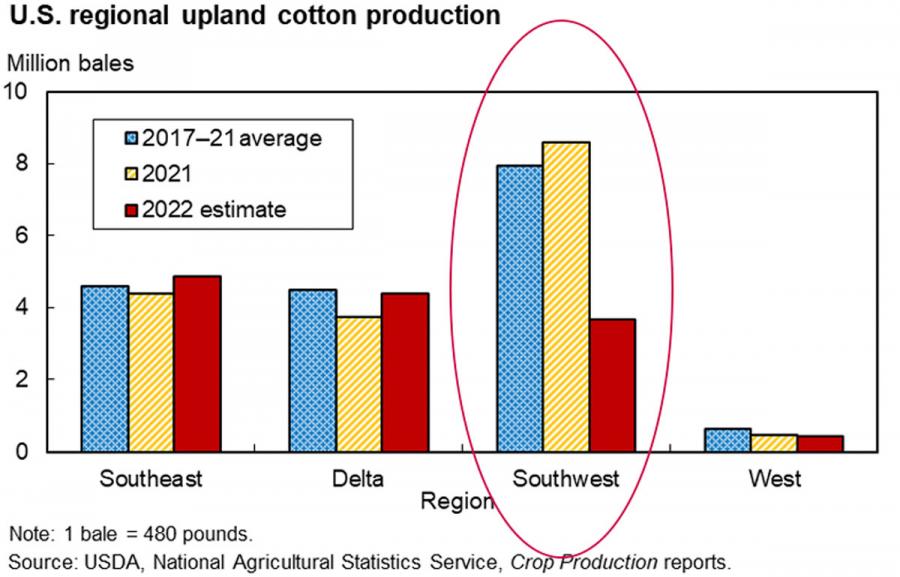SAN ANGELO, TX — Unless Congress acts now, the major piece of our region's agriculture infrastructure may fail, driving away the ability to deliver the region's cotton crops to market in future years.
Cotton is the leading cash crop in Texas and the state ranks first in U.S. cotton production. Cotton generates $1.6 billion for farmers, with a state-wide economic impact of $5.2 billion. Most of the cotton in Texas is grown on the South Plains, from cotton fields east of San Angelo and northward through north Texas and throughout the Panhandle.
The infrastructure needed to harvest San Angelo area cotton revolves around our ginning capacity. Both gins, Lone Star Gin in Mereta and the Wall Co-Op Gin in Wall, need about 30,000 bales a year each to gin in order to break even. This year, each gin will be lucky to gin 13,000 bales a piece, less than half needed to break even. Across the Texas cotton-growing region, some gins may not open this year at all.
The market price for cotton fell through the floor in June 2022, falling almost overnight from $1.42 per pound to $1.00 per pound after U.S. trade policy was shifted against China. Since June, as speculators exited the market, cotton has fallen further where yesterday, Dec. 14, the price per pound was at $0.84.
Cotton industry experts also say that the Covid shutdowns in China and the anticipation of a slowing global economy contributed to an extreme drop-off in demand. According to the U.S. Department of Agriculture, "China is by far the world’s leader in processing raw cotton fiber into textiles and apparel." Since 2020, China has been the leading buyer of U.S. cotton. In 2020, for example, China imported $1.8 billion in U.S. cotton. That fell to $1.3 billion in 2021. In 2023, exports to China are expected to be further down, according to the USDA. If the Chinese factories are not running at capacity, the U.S. cotton export market is negatively impacted.
The Plains cotton planters were also impacted by a drought and record heat over the summer. In the U.S. Southwest region that includes most of Texas, cotton production is about half the average of the years 2017-2021. There isn't enough cotton being harvested to support the gin infrastructure in Texas this year (see chart below):

US Cotton Production by region, 2022
Maintaining the capacity of the gins is paramount for the region's agriculture industry's health. If the gins shutdown for good, when Plains cotton planters once again produce a bounty crop, the capability to deliver the region's cotton to market will be severely hampered.
In light of this, all three congressmen representing Amarillo, Lubbock, and San Angelo urged the U.S. Congress to fully fund the U.S. Department of Agriculture’s (USDA) Emergency Relief Program (ERP) for the 2022 crop year and adequate assistance for cotton infrastructure – especially cotton gins – to help mitigate the devastating production losses farmers and ranchers have experienced this past year.
Congressman Ronny Jackson (TX-13 — Amarillo and Wichita Falls) said, "The devastating drought we experienced this year is a serious threat to everything our cotton farmers have built, and it is not something Congress can ignore. The cotton industry is critical to the success and vibrancy of the communities I represent in TX-13."
"Without an extension of the Emergency Relief Program (ERP), this year’s losses will be devastating to our communities that support and depend on agriculture. Congress must provide this relief immediately," Congressman August Pfluger (TX-11) added.
Rep. Jodey Arrington (TX-19 — Lubbock) echoed Pfluger and Jackson, "Unfortunately, producers across the nation have experienced unprecedented challenges this year — from historic drought conditions to record input costs, supply chain disruptions, and labor shortages."
Kody Bessent, CEO of the Plains Cotton Growers, Inc. is most concerned about the survival of the region's cotton gins and wants to provide them relief.
"We look forward to working with Congress to ensure these key initiatives are addressed in the upcoming omni legislative package," he said.
Texas Farm Bureau President Russell Boening also expressed concern for the gins.
"We are also glad the letter addresses the needs of cotton gins that have faced economic challenges due to staggering crop losses this year. We urge the inclusion of these provisions in the FY2023 appropriations package and look forward to continuing to work toward solutions that will keep farmers and ranchers in operation," he said.
The full letter to fellow congress members can be found here. Additional cosigners include Representatives Kevin Brady (TX-08), Pete Sessions (TX-17), Henry Cuellar (TX-28), Louie Gohmert (TX-01), Vicente Gonzalez (TX-15), Michael Cloud (TX-27), Lance Gooden (TX-05), Troy Nehls (TX-22), Pat Fallon (TX-04), Jake Ellzey (TX-06), and Brian Babin (TX-36).
Subscribe to the LIVE! Daily
Required






Comments
"Democrats are about twice as likely as Republicans to have received food stamps at some point in their lives—a participation gap that echoes the deep partisan divide in the U.S. House of Representatives, which on Thursday produced a farm bill that did not include funding for the food stamp program.
Of these, about one-in-five (22%) of Democrats say they had received food stamps compared with 10% of Republicans."
I'd say so.
- Log in or register to post comments
PermalinkYes because food stamps aren't handouts right?.. WEIRD
- Log in or register to post comments
PermalinkPost a comment to this article here: